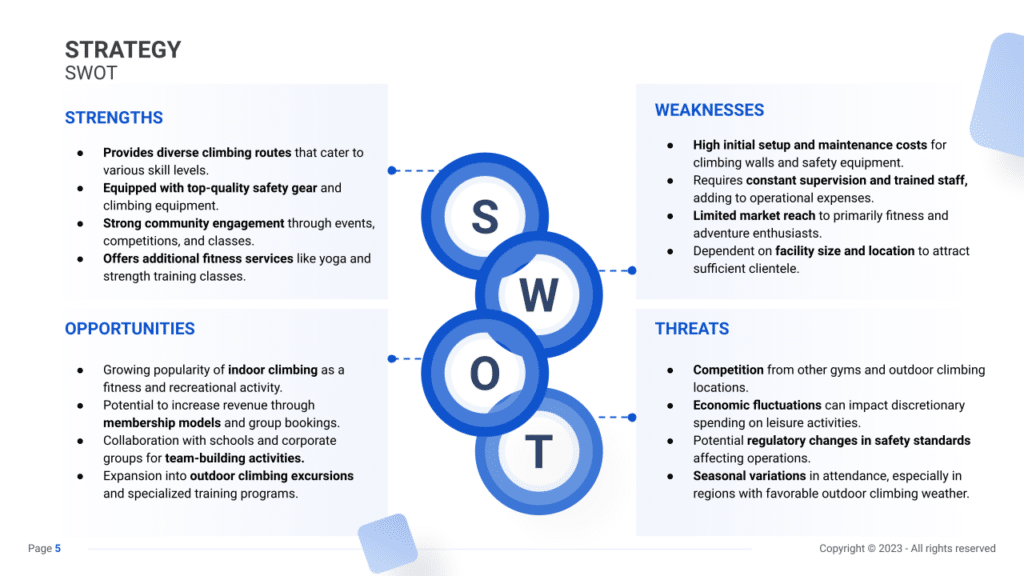SWOT Analysis for a Rock Climbing Gym (Example)

A SWOT analysis is crucial for developing a business plan for a rock climbing gym. This analysis, which stands for Strengths, Weaknesses, Opportunities, and Threats, helps understand internal and external factors that can impact your business. Strengths and weaknesses are internal to the business, while opportunities and threats are external.
In this article, we will explore various examples of strengths, weaknesses, opportunities, and threats, aiding gym owners in devising effective strategies for success.

Strengths
Highlight the unique advantages that distinguish your rock climbing gym, fostering a competitive edge and customer loyalty.
- Diverse Climbing Facilities: Offering a comprehensive array of climbing walls, bouldering areas, and specialized terrain, it caters to climbers of all skill levels.
- Example: Highlight the diversity in climbing options through promotional materials, attracting beginners and seasoned climbers alike.
- Experienced and Passionate Instructors: Employing knowledgeable and passionate instructors fosters a supportive learning environment and enhances the gym’s credibility.
- Example: Showcase instructor profiles and expertise on the gym’s website or social media platforms, building trust among potential members.
- Innovative Training Programs: Providing innovative training modules, such as technique workshops or strength-building sessions, adds significant value for climbers.
- Example: Promote these unique programs through targeted marketing campaigns, attracting enthusiasts seeking specialized training.
- Active Community Engagement: Cultivating a vibrant and connected climbing community through events, competitions, and member gatherings encourages long-term membership retention.
- Example: Organize regular social events or themed climbing competitions to strengthen the gym’s community spirit.
Weaknesses
Identify and address internal limitations to fortify the Rock Climbing Gym for sustained success.
- Space Constraints: Limited space may restrict the number of climbers during peak hours, potentially impacting the overall experience.
- Example: Manage space effectively by introducing booking systems or considering expansion opportunities where feasible.
- High Maintenance Costs: Regular upkeep and maintenance of climbing walls and safety equipment result in substantial ongoing expenses.
- Example: Explore partnerships with equipment suppliers or implement strict maintenance schedules to control costs.
- Seasonal Variability: Climbing may be more seasonal in certain regions, leading to fluctuations in member engagement during off-peak periods.
- Example: Introduce off-season promotions or diversify services to maintain consistent engagement year-round.
- Staff Dependency: Relying on a limited number of skilled staff members might pose operational challenges during staff shortages or high demand.
- Example: Invest in comprehensive staff training programs and develop contingency plans for staffing emergencies.
Opportunities
Identify avenues for expansion and innovation to elevate the Rock Climbing Gym’s offerings.
- Adventure Tourism Collaborations: Partnering with local adventure tourism agencies or outdoor activity groups can attract tourists seeking indoor climbing experiences.
- Example: Collaborate to offer combined outdoor adventures with gym access, enticing travelers to experience indoor climbing.
- Technological Integration: Embrace innovative technologies such as virtual reality climbing experiences or mobile apps to enhance the overall climbing experience.
- Example: Develop an interactive app for climbers to track progress, participate in challenges, and engage with the climbing community.
- Corporate Engagement Programs: Tailoring team-building packages for corporate clients fosters business relationships and introduces new clientele.
- Example: Design specialized team-building activities and market them to local businesses for staff engagement events.
- Youth and Educational Programs: Developing youth-focused programs or partnerships with schools can create a pipeline for the next generation of climbers.
- Example: Collaborate with educational institutions to offer after-school climbing clubs or educational workshops on climbing techniques.
Threats
Anticipate potential external threats to fortify the Rock Climbing Gym’s resilience.
- Market Saturation: Increased competition from new gyms or outdoor climbing alternatives might challenge the gym’s market share.
- Example: Focus on unique offerings, exceptional services, or specialized training to differentiate from competitors.
- Regulatory Changes: Alterations in safety or zoning regulations may require costly modifications or operational adjustments.
- Example: Stay updated on local regulations and allocate resources for necessary compliance measures proactively.
- Economic Instabilities: Economic fluctuations can impact discretionary spending, potentially leading to reduced memberships or class enrollments.
- Example: Introduce flexible payment plans or loyalty programs during economic downturns to retain customers.
- Safety and Legal Concerns: Accidents or injuries related to climbing activities could pose legal liabilities or damage the gym’s reputation.
- Example: Emphasize stringent safety protocols, conduct regular safety checks, and provide comprehensive training to staff members.





